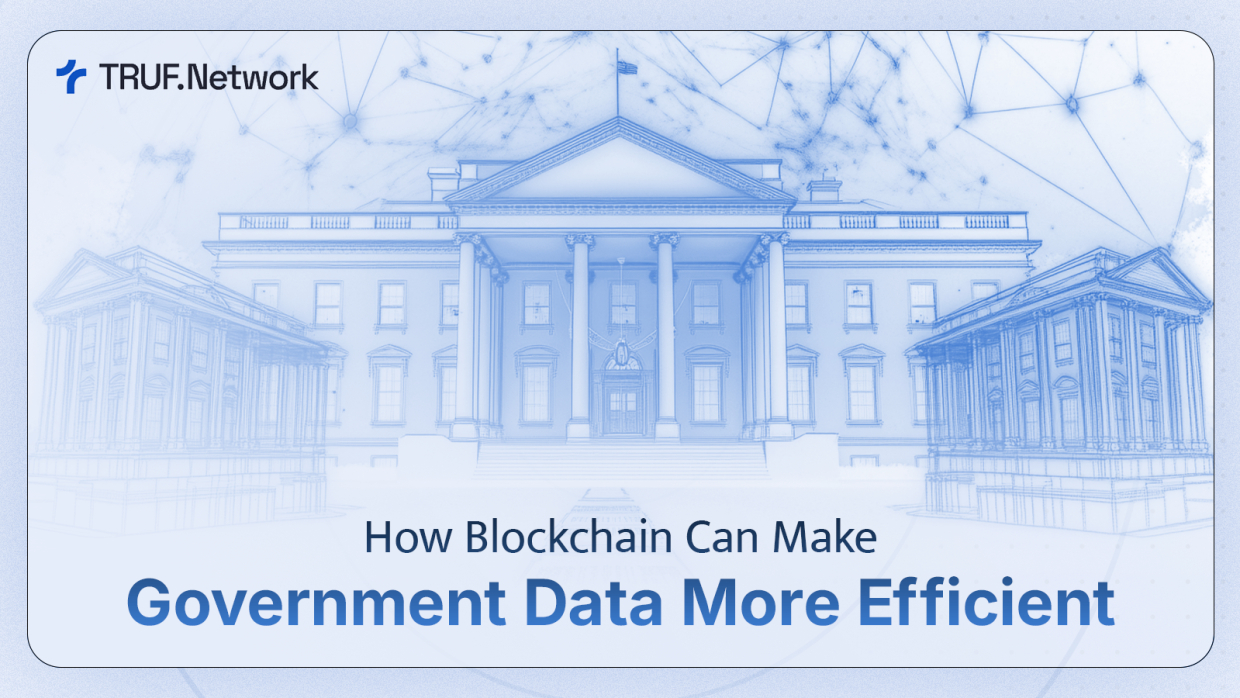How Blockchain Can Make Government Data More Efficient
Blockchain technology offers a transformative solution by introducing transparency, security, and automation, making government data management more efficient.

Governments handle vast amounts of data, from citizen records to financial transactions, land registries, and supply chains.
However, managing this data efficiently is a persistent challenge due to bureaucracy, security risks, and outdated systems.
Blockchain technology offers a transformative solution by introducing transparency, security, and automation, making government data management more efficient.
How DOGE Transformed the Perspective on Government Efficiency Data
The Department of Government Efficiency (DOGE) has significantly altered how the public perceives and interacts with government performance data.
Traditionally, efficiency metrics were buried in complex reports, accessible only to specialists.
However, with the implementation of DOGE’s data-driven approach, transparency, accountability, and decision-making processes have undergone a major shift.
- Data-Driven Decision Making: Using technology to track spending, project outcomes, and operational efficiency.
- Increased Public Engagement and Transparency: DOGE has enabled citizens, journalists, and watchdog organizations to actively monitor government efficiency.
- Performance Benchmarking Across Agencies: This has encouraged a culture of accountability and continuous improvement.
- Cost Reduction and Resource Optimization: DOGE’s impact on budgetary efficiency is evident.
- A Shift in How We Evaluate Government Success: It has encouraged governments to prioritize results, efficiency, and public satisfaction over mere bureaucratic expansion.
DOGE has fundamentally changed how we view government efficiency by bringing data to the forefront of decision-making, increasing transparency, and encouraging performance-driven policies.
As governments continue to adopt data-centric governance, this transformation ensures smarter resource allocation, improved public services, and a more accountable administration.
The 5 Fundamental Changes That Blockchain Can Bring
This new social paradigm, where citizens can closely monitor government spending and programs, can be helped by technology, especially by blockchain.
Let’s understand its main fundamentals and then we’ll take a deeper look at Truflation and TRUF.NETWORK’s solutions.
The creation of an ecosystem where citizens can closely monitor government spending and programs, where corruption is mitigated and public money is truly directed to its original source.
1. Enhancing Transparency and Trust
One of the biggest advantages of blockchain is its immutable ledger, which records transactions in a way that cannot be altered or deleted. This makes it an ideal tool for increasing transparency in public administration. When government records, such as budgets, expenditures, and contracts, are stored on a blockchain, citizens and auditors can access real-time, tamper-proof data.
This reduces corruption and improves trust in government institutions.
Example: Estonia has implemented blockchain technology for secure digital identity management, enabling citizens to access public services transparently.
2. Reducing Bureaucracy and Administrative Costs
Government processes are often slow and costly due to reliance on paper-based documentation and manual verification.
Smart contracts, self-executing agreements stored on the blockchain, can automate many of these processes, reducing paperwork and human intervention.
Use Cases:
Tax Collection: Blockchain can streamline tax payments by automating compliance and reducing errors.
Land Registries: Property transactions can be recorded transparently, preventing fraud and disputes.
Licensing and Permits: Business registration and permit issuance can be faster and more secure through smart contracts.
3. Strengthening Data Security and Privacy
Governments store sensitive citizen data, making them frequent targets for cyberattacks. Blockchain enhances security by decentralizing data storage, making it harder for hackers to manipulate or steal information.
How It Works:
- Decentralization: Data is not stored in a single vulnerable location but across multiple nodes.
- Encryption: Advanced cryptographic techniques protect personal information.
- Access Control: Citizens can control who accesses their data, reducing the risk of breaches.
Example: The UAE government is using blockchain to secure public records and reduce fraud.
4. Improving Public Service Delivery
Blockchain can revolutionize how governments deliver essential services, such as welfare programs, voting systems, and healthcare.
Potential Improvements:
- Welfare Distribution: Blockchain-based digital identities and wallets can ensure that aid reaches the right recipients, reducing fraud and inefficiencies.
- Voting Systems: Secure, transparent voting records can eliminate election fraud and increase voter confidence.
- Healthcare Records: A unified, secure blockchain system can allow seamless sharing of medical records while maintaining patient privacy.
Example: In Sierra Leone, blockchain was tested for elections to enhance voting transparency.
5. Increasing Efficiency in Government Supply Chains
Governments manage complex supply chains for infrastructure projects, healthcare supplies, and military logistics.
Blockchain can ensure transparency in procurement, track goods in real time, and prevent fraud.
This allows the population to check whether what was proposed is actually being delivered.
Use Case:
- Defense and Public Works: Blockchain can track every stage of government contracts, ensuring compliance and reducing waste.
How Real-Time Economic Data and Truflation Can Improve Government Efficiency
Besides making government data more efficient, blockchain can also enable real-time economic data through solutions like Truflation.
Governments have long relied on lagging economic indicators to shape policies, budget allocations, and social programs.
However, in an era of real-time data analytics, traditional reporting methods are being challenged by faster, decentralized, and more accurate alternatives.
One of the key innovations in this space is Truflation, a blockchain-based inflation tracking system that provides real-time economic insights.

When governments embrace these real-time economic data solutions, efficiency, responsiveness, and decision-making improve dramatically. Some of the advantages are:
1. Faster Policy Adjustments and Economic Response
Traditional economic data, like inflation reports or unemployment numbers, are often delayed by weeks or months, Truflation provides instant insights, allowing policymakers to adjust interest rates, subsidies, or fiscal policies more efficiently.
2. Increased Transparency and Trust in Government Data
One of the biggest criticisms of government economic data is that it can be manipulated, politically biased, or outdated.
Truflation pulls data from multiple independent sources, This improves public trust, accountability, and the quality of data. Data integrity is more important than political agendas.
3. More Efficient Public Spending and Budget Allocation
If economic conditions shift rapidly, misallocations occur, wasting taxpayer money. With real-time economic monitoring, governments can adjust welfare programs dynamically, and allocate resources based on current, not outdated, economic conditions.
This works for resource allocation and also monetary policy decision-making, This can avoid economic distortions.
You may have wondered, what is behind Truflation? Let’s understand this.
The role of TRUF.NETWORK
Behind Truflation’s inflation indices is a robust data system.
All the infrastructure that powers Truflation’s raw data and composable indexes on the blockchain is hosted on TRUF.NETWORK, which plays a key role in data management.
TRUF.NETWORK is a decentralized platform designed to bring real-time economic data with unmatched transparency and accuracy.
Powered by the TRUF token, it operates on a Byzantine Fault Tolerant blockchain, ensuring secure and reliable data processing.
What sets it apart is its use of PostgreSQL and SQL-based smart contracts, which allow for efficient and verifiable calculations of Real World Assets (RWA) and economic indexes.

Built from Truflation’s mission to revolutionize economic data, TRUF.NETWORK eliminates delays, biases, and distortions in traditional government-reported numbers.
Whether tracking inflation, GDP, or financial metrics, the platform delivers real-time insights that can be used by governments, businesses, and investors to make better decisions.
By combining blockchain security with database efficiency, TRUF.NETWORK is redefining how we measure and understand the global economy.
Final Thoughts
The integration of real-time economic data and blockchain-based solutions like Truflation and TRUF.NETWORK are reshaping how governments manage economic policy and public resources.
By leveraging these innovations, policymakers can make faster, more accurate decisions, enhance budget efficiency, and build public trust through greater transparency.
While challenges such as regulatory adaptation and implementation costs remain, early adopters have already demonstrated the transformative potential of data-driven governance.
As governments continue to embrace real-time economic monitoring and decentralized technologies, public services will become more efficient, responsive, and equitable—ultimately benefiting both citizens and administrations.
Blockchain can make the world more transparent and we are your source of truth.


